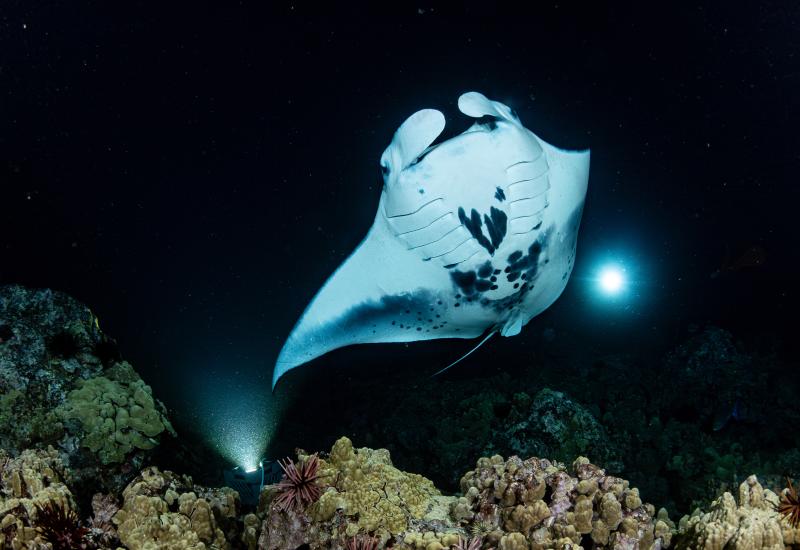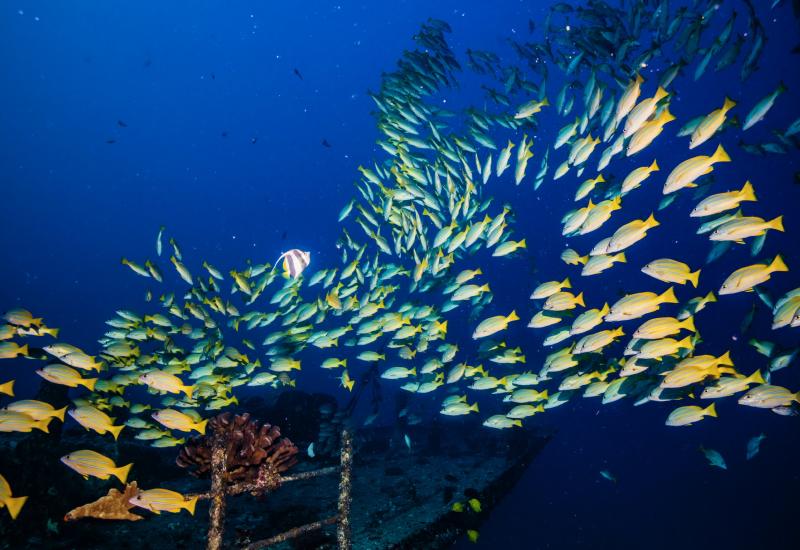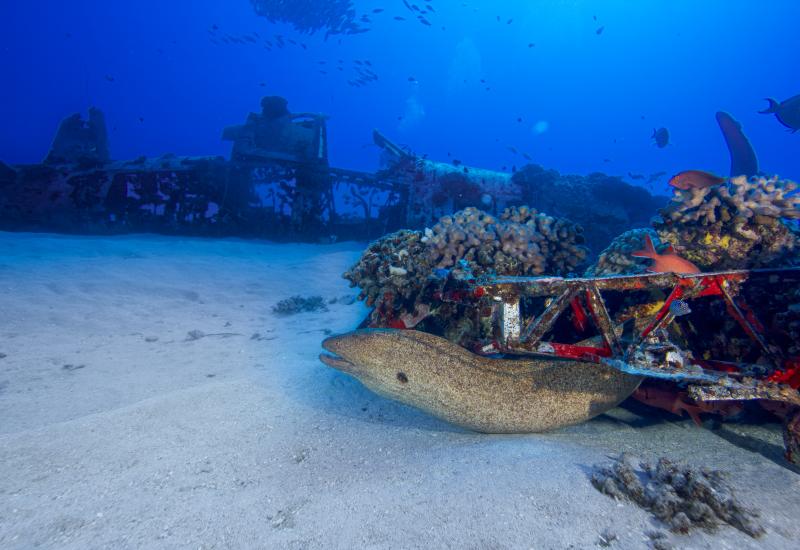Tulamben Bay, Bali
 |
| A sweetlips cruises by an encrusted mast from the ship that rests on the seafloor. |
June 2001
By Susan Tunis
Photography by Robert Yin
The dates of the trip are set. For the first time in a diving career that has spanned more than 40 years, I am going to Bali. Unable to contain my enthusiasm, I sit in my office discussing the trip with coauthor Susan Tunis. She looks at me like I'm crazy.
"When I was a boy, I read about Bali in National Geographic," I say. "It was so exotic! The women went topless ..." Susan rolls her eyes.
Soon enough, I learn that no matter how vivid my schoolboy memories, they are no match for the reality of contemporary Bali.
Portrait of an Island
As Indonesian islands go, Bali is fairly small, about 84 miles long by 48 miles wide, situated between the Bali Sea to the north and the Indian Ocean to the south. It is also volcanic, and the volcanoes here are decidedly active. There hasn't been a major eruption since 1963, but there will be another one some day. The volcanic nature of the island is as much a blessing as a curse, because the rich volcanic soil is one reason that Bali is so exceptionally verdant.
The towns of Bali are startlingly clean and lovely, and the (fully clothed) people are exceptionally friendly. The vast majority of the population is Hindu, and religion pervades life on Bali. There is evidence of it everywhere you look, including beautiful and ornate temples on virtually every street corner. The Balinese people make constant sacrifices to their gods, sometimes with a gesture as small as leaving half a banana at a temple, other times through elaborate ceremonies to the volcano god or the rice goddess.
 |
| The wreck of the 395-foot cargo freighter Liberty is one of Bali's top dive sites. |
Getting Started
Regardless of how appealing the culture, the land and the people may be, it is the water, nonetheless, that has lured us here. We will be diving a relatively small section of the northeastern coast called Tulamben Bay. To get there, we have to fly into Denpasar, and we spend the night in Kuta before continuing on. Kuta Beach is a resort town. Walking down the street past shops bearing the names Ralph Lauren and Giorgio Armani, you could easily mistake this place for any stylish European capital. Tourism is important to Bali's economy, and there is a well-developed infrastructure.
The following morning we wake for an early start on the three-hour drive to Tulamben. We arrive at the Dive Paradise Resort in good time, unpack and immediately begin preparing for our first dive. These preparations are absurdly simple because in Tulamben Bay all the diving is right off the beach in front of the resort. Even carrying your gear is no problem, as there are a host of girls and women standing by who will handle the task admirably at a price of just pennies a day. It's amazing to see these young women with tanks piled on their heads, walking as if unencumbered. Truthfully, I'm quite glad to have the help. The beach is rocky, rather than sandy, and I find the footing unsteady.
Give Me Liberty
Instead of visiting the resort's house reef straight off, we opt to venture a little farther up the beach to Tulamben Bay's other big attraction. This is the wreck of the Liberty, a WWI-era cargo freighter that was torpedoed by the Japanese in 1942. Her allied escorts couldn't get her to Singaraja for repairs, but did manage to beach her in the shallows of Tulamben Bay. There she sat for more than two decades. It was the 1963 volcanic eruption that literally shook, rattled and rolled the wreck into deeper water. Now she sits, more or less intact, in about 95 feet of water. The top of the wreck is only 10 feet from the surface, and if Liberty weren't a mere 100 feet from the beach, she would surely be a hazard to navigation.
Far from being a hazard, Liberty is one of Bali's top underwater attractions. After 38 years under water, the ship is thoroughly encrusted with marine life, including sponges, gorgonians, hard and soft corals, anemones, oysters and much more. Flitting in, out and around the wreck are a wide variety of fish. Schools include batfish, snappers, sweetlips and jacks. Even flashlight fish can be found schooling in a couple different areas of the wreck, and are a blast to view on a moonlit night dive.
Other types of fish that can be found on their own or in small groups include jawfish, scorpionfish, gobies, groupers, pipefish, crocodilefish and a few types of rays. There is little current on the wreck, and that, coupled with the ship's proximity to shore, may explain the lack of large animals.
The wreck itself is in fairly good condition, but time and tide will surely take a toll. There are several recognizable structures remaining on the wreck, but the propeller is not among them; it was salvaged by entrepreneurs shortly after the ship stranded on Tulamben's beach. There are several spots that will allow divers to safely penetrate the wreck.
Liberty was our first dive, and it was absolutely everything we could ask for. In the days and weeks that followed, we found ourselves returning to the wreck again and again, never tiring in our explorations.
 |
| Evidence of the rich religious life of the predominantly Hindu population of Bali can be found everywhere on the island, including in its many ornate temples. |
Black Sand, Red Fish
The following day we began exploring the coral reefs that are found in the shallows immediately offshore. Under water, the rocky terrain quickly gives way to black volcanic sand. (This sand makes an exceptional backdrop for underwater photographs.) The reef isn't deep, ranging from about 15 to 65 feet in depth. Reaching the reef, one of the first things to catch my eye is a school of bright red squirrelfish, incredibly vivid in the bright morning light.
The reef stretches for several hundred feet and is composed primarily of hard corals, with several patches of fire coral scattered about. It would be easy to let the variety of fish distract you to the point that you miss the rich macro life nestled among the nooks and crannies of this reef. There are tunicates sprouting in colorful patches and bouquets of tube worms. A minuscule orange crab does its best to blend with the arm of the sea star on which it resides. One of the more photogenic creatures I discovered that morning was a translucent violet shrimp clinging to a vibrant red crinoid.
As with the Liberty wreck, we returned again and again to this reef. At one point I discovered an excellent cleaning station, and spent several dives photographing the activity. As access to the reef was effortless, we made quite a few night dives as well. One evening around dusk we had the opportunity to watch the coral spawning, the water clouded with millions of gametes.
Other areas of interest in Tulamben Bay include a drop-off slightly southeast of the resorts and the sandy area found next to it. The sand patch is, in reality, the delta of a river entering the sea. Initially overlooked by most divers, it is actually one of the most interesting sites in the bay. There are some unusual animals waiting to be discovered in the sand, and a stealthy photographer may capture images of the garden eels that make their home there. Even if you're not shooting, there's something hypnotic about watching these shy animals sway with the current.
Tulamben Bay is probably the best dive region in Bali, but there are several other areas nearly as popular. It is a testament to the amazing marine life and the wonderful conditions in Tulamben Bay that one never tires of returning. Each dive is unique.
I've already made plans to come back next year and visit Secret Bay and Nusa Penida, but I suspect any trip to Bali will remain incomplete without a return to Tulamben Bay.
Dive In: Bali
Getting There: The easiest way to get to Bali is to fly into Denpasar Airport, Bali's only international airport. A wide selection of airlines offers service to Denpasar, including United, Cathay Pacific, American, Continental and Garuda Indonesia.
Air and Water Temperatures: Air temperature averages around 85F. Water temperature is normally around 85F, but can drop to below 70F with upwelling currents.
Money Matters: The local currency is the rupiah. Due to the recent depreciation of the rupiah in relation to the U.S. dollar, necessities including meals, lodging and transportation may appear very inexpensive to American tourists. A taxi from town to your hotel may cost less than a dollar, and a decent meal can be as little as one dollar.
Resorts:
Dive Paradise Tulamben
Emerald Tulamben Beach Hotel
Tauch Terminal Resort Tulamben
Mimpi Tulamben
Bali Hyatt Hotel (Sanur Beach)
Oka Wati's Sunset Bungalows (Ubud)
Live-Aboard:
Baruna
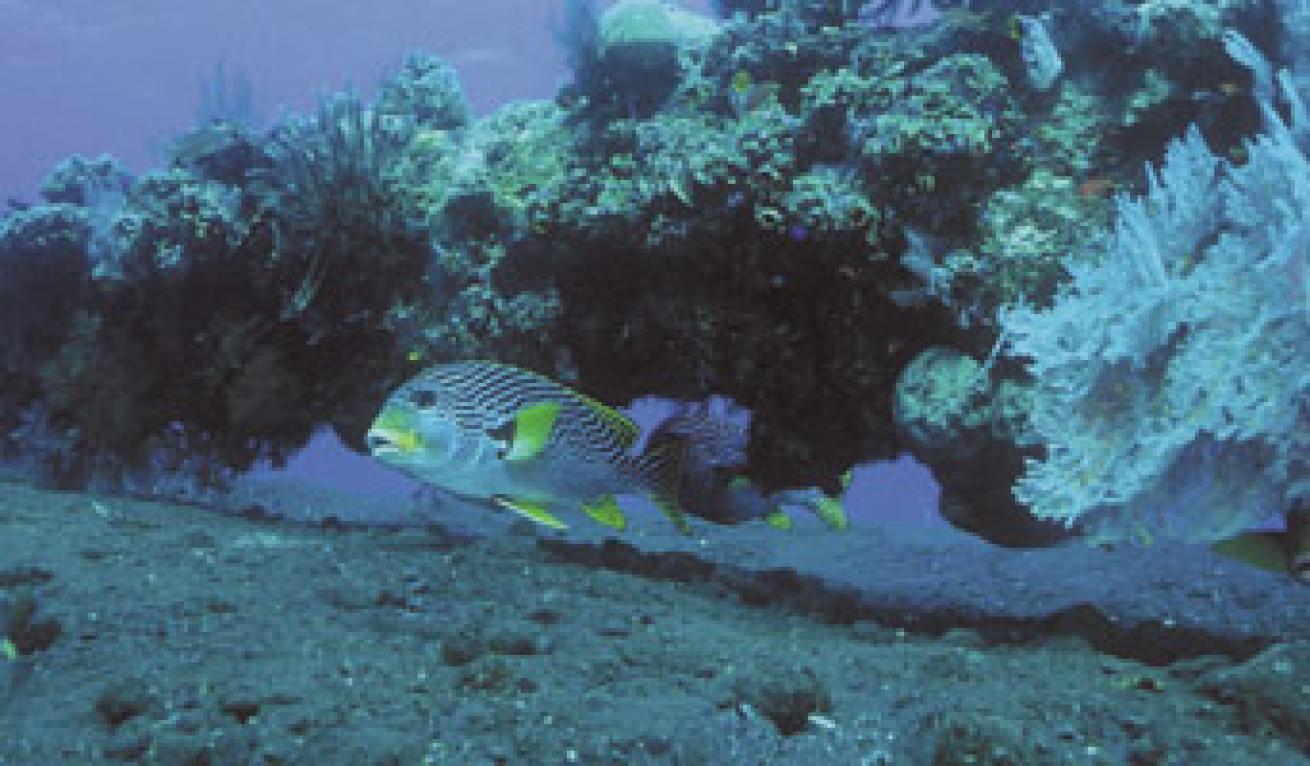
A sweetlips cruises by an encrusted mast from the ship that rests on the seafloor.
June 2001
By Susan Tunis
Photography by Robert Yin
The dates of the trip are set. For the first time in a diving career that has spanned more than 40 years, I am going to Bali. Unable to contain my enthusiasm, I sit in my office discussing the trip with coauthor Susan Tunis. She looks at me like I'm crazy.
"When I was a boy, I read about Bali in National Geographic," I say. "It was so exotic! The women went topless ..." Susan rolls her eyes.
Soon enough, I learn that no matter how vivid my schoolboy memories, they are no match for the reality of contemporary Bali.
Portrait of an Island
As Indonesian islands go, Bali is fairly small, about 84 miles long by 48 miles wide, situated between the Bali Sea to the north and the Indian Ocean to the south. It is also volcanic, and the volcanoes here are decidedly active. There hasn't been a major eruption since 1963, but there will be another one some day. The volcanic nature of the island is as much a blessing as a curse, because the rich volcanic soil is one reason that Bali is so exceptionally verdant.
The towns of Bali are startlingly clean and lovely, and the (fully clothed) people are exceptionally friendly. The vast majority of the population is Hindu, and religion pervades life on Bali. There is evidence of it everywhere you look, including beautiful and ornate temples on virtually every street corner. The Balinese people make constant sacrifices to their gods, sometimes with a gesture as small as leaving half a banana at a temple, other times through elaborate ceremonies to the volcano god or the rice goddess.
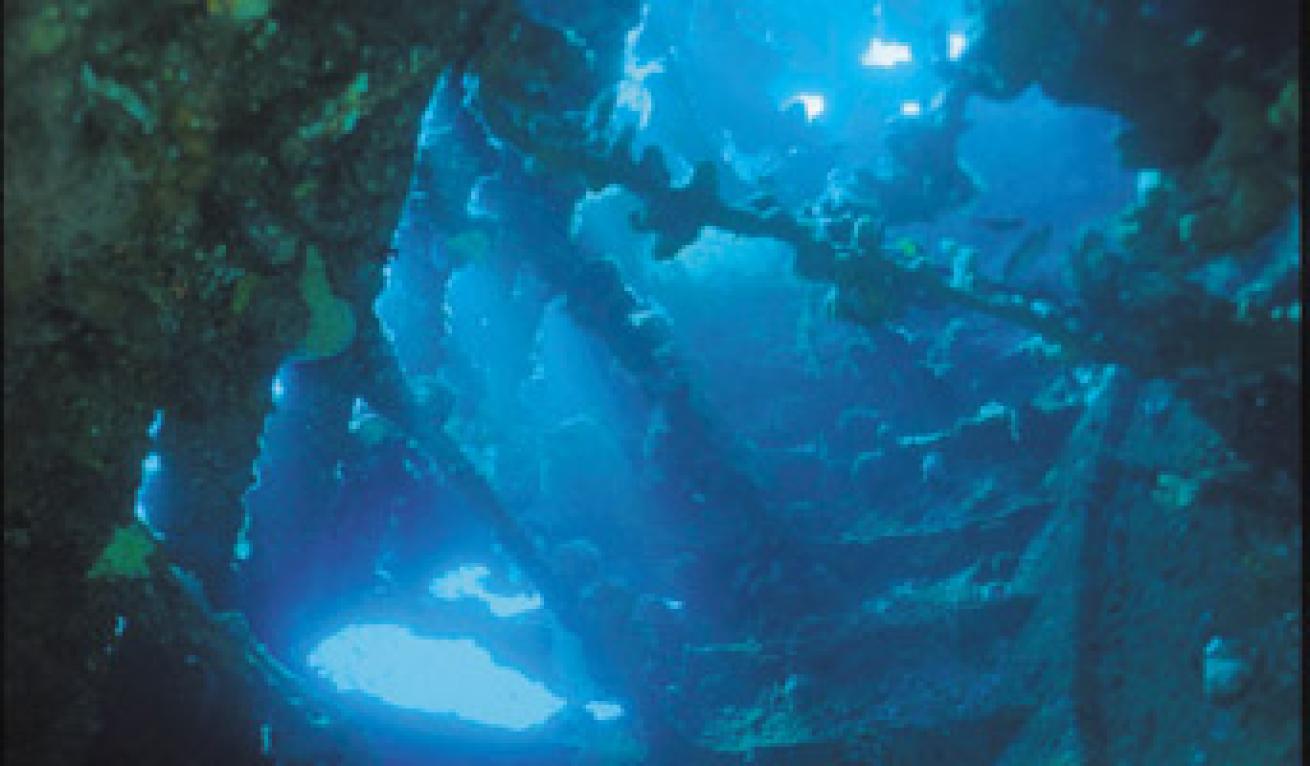
The wreck of the 395-foot cargo freighter Liberty is one of Bali's top dive sites.
Getting Started
Regardless of how appealing the culture, the land and the people may be, it is the water, nonetheless, that has lured us here. We will be diving a relatively small section of the northeastern coast called Tulamben Bay. To get there, we have to fly into Denpasar, and we spend the night in Kuta before continuing on. Kuta Beach is a resort town. Walking down the street past shops bearing the names Ralph Lauren and Giorgio Armani, you could easily mistake this place for any stylish European capital. Tourism is important to Bali's economy, and there is a well-developed infrastructure.
The following morning we wake for an early start on the three-hour drive to Tulamben. We arrive at the Dive Paradise Resort in good time, unpack and immediately begin preparing for our first dive. These preparations are absurdly simple because in Tulamben Bay all the diving is right off the beach in front of the resort. Even carrying your gear is no problem, as there are a host of girls and women standing by who will handle the task admirably at a price of just pennies a day. It's amazing to see these young women with tanks piled on their heads, walking as if unencumbered. Truthfully, I'm quite glad to have the help. The beach is rocky, rather than sandy, and I find the footing unsteady.
Give Me Liberty
Instead of visiting the resort's house reef straight off, we opt to venture a little farther up the beach to Tulamben Bay's other big attraction. This is the wreck of the Liberty, a WWI-era cargo freighter that was torpedoed by the Japanese in 1942. Her allied escorts couldn't get her to Singaraja for repairs, but did manage to beach her in the shallows of Tulamben Bay. There she sat for more than two decades. It was the 1963 volcanic eruption that literally shook, rattled and rolled the wreck into deeper water. Now she sits, more or less intact, in about 95 feet of water. The top of the wreck is only 10 feet from the surface, and if Liberty weren't a mere 100 feet from the beach, she would surely be a hazard to navigation.
Far from being a hazard, Liberty is one of Bali's top underwater attractions. After 38 years under water, the ship is thoroughly encrusted with marine life, including sponges, gorgonians, hard and soft corals, anemones, oysters and much more. Flitting in, out and around the wreck are a wide variety of fish. Schools include batfish, snappers, sweetlips and jacks. Even flashlight fish can be found schooling in a couple different areas of the wreck, and are a blast to view on a moonlit night dive.
Other types of fish that can be found on their own or in small groups include jawfish, scorpionfish, gobies, groupers, pipefish, crocodilefish and a few types of rays. There is little current on the wreck, and that, coupled with the ship's proximity to shore, may explain the lack of large animals.
The wreck itself is in fairly good condition, but time and tide will surely take a toll. There are several recognizable structures remaining on the wreck, but the propeller is not among them; it was salvaged by entrepreneurs shortly after the ship stranded on Tulamben's beach. There are several spots that will allow divers to safely penetrate the wreck.
Liberty was our first dive, and it was absolutely everything we could ask for. In the days and weeks that followed, we found ourselves returning to the wreck again and again, never tiring in our explorations.
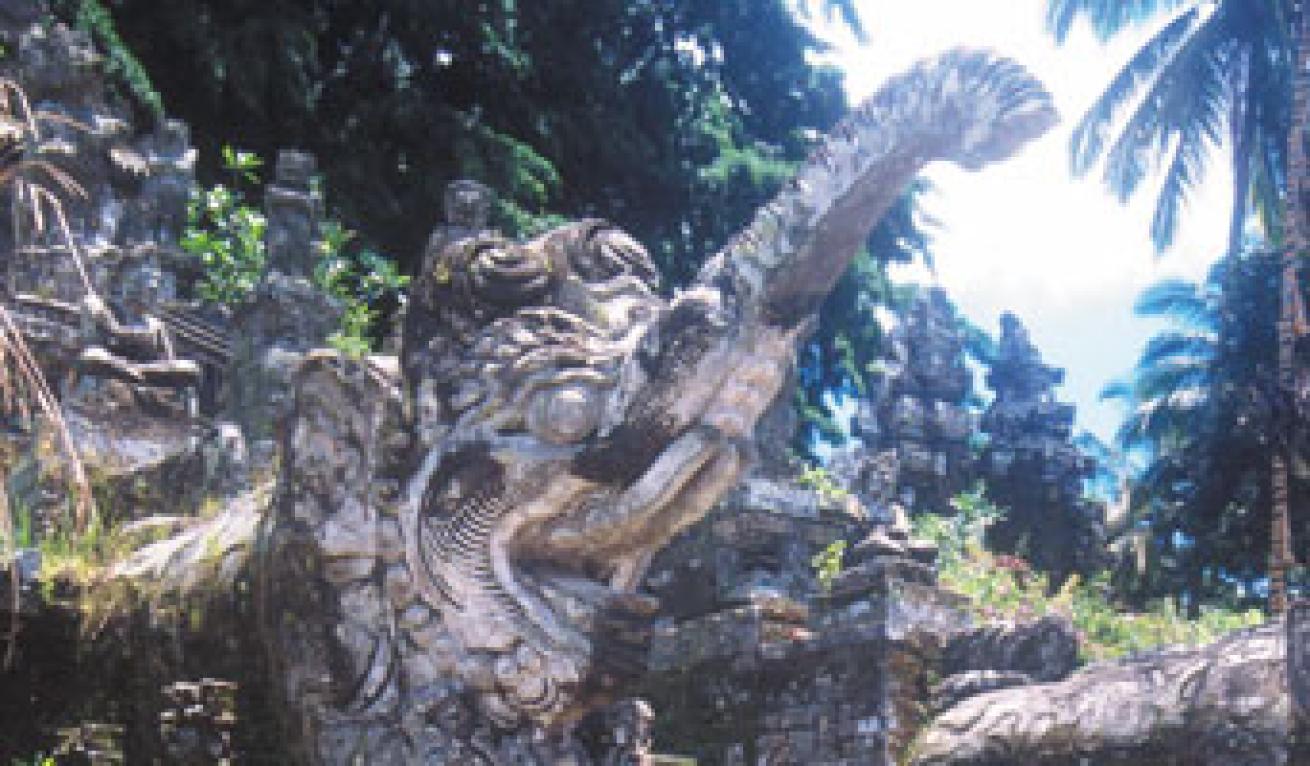
Evidence of the rich religious life of the predominantly Hindu population of Bali can be found everywhere on the island, including in its many ornate temples.
Black Sand, Red Fish
The following day we began exploring the coral reefs that are found in the shallows immediately offshore. Under water, the rocky terrain quickly gives way to black volcanic sand. (This sand makes an exceptional backdrop for underwater photographs.) The reef isn't deep, ranging from about 15 to 65 feet in depth. Reaching the reef, one of the first things to catch my eye is a school of bright red squirrelfish, incredibly vivid in the bright morning light.
The reef stretches for several hundred feet and is composed primarily of hard corals, with several patches of fire coral scattered about. It would be easy to let the variety of fish distract you to the point that you miss the rich macro life nestled among the nooks and crannies of this reef. There are tunicates sprouting in colorful patches and bouquets of tube worms. A minuscule orange crab does its best to blend with the arm of the sea star on which it resides. One of the more photogenic creatures I discovered that morning was a translucent violet shrimp clinging to a vibrant red crinoid.
As with the Liberty wreck, we returned again and again to this reef. At one point I discovered an excellent cleaning station, and spent several dives photographing the activity. As access to the reef was effortless, we made quite a few night dives as well. One evening around dusk we had the opportunity to watch the coral spawning, the water clouded with millions of gametes.
Other areas of interest in Tulamben Bay include a drop-off slightly southeast of the resorts and the sandy area found next to it. The sand patch is, in reality, the delta of a river entering the sea. Initially overlooked by most divers, it is actually one of the most interesting sites in the bay. There are some unusual animals waiting to be discovered in the sand, and a stealthy photographer may capture images of the garden eels that make their home there. Even if you're not shooting, there's something hypnotic about watching these shy animals sway with the current.
Tulamben Bay is probably the best dive region in Bali, but there are several other areas nearly as popular. It is a testament to the amazing marine life and the wonderful conditions in Tulamben Bay that one never tires of returning. Each dive is unique.
I've already made plans to come back next year and visit Secret Bay and Nusa Penida, but I suspect any trip to Bali will remain incomplete without a return to Tulamben Bay.
Dive In: Bali
Getting There: The easiest way to get to Bali is to fly into Denpasar Airport, Bali's only international airport. A wide selection of airlines offers service to Denpasar, including United, Cathay Pacific, American, Continental and Garuda Indonesia.
Air and Water Temperatures: Air temperature averages around 85F. Water temperature is normally around 85F, but can drop to below 70F with upwelling currents.
Money Matters: The local currency is the rupiah. Due to the recent depreciation of the rupiah in relation to the U.S. dollar, necessities including meals, lodging and transportation may appear very inexpensive to American tourists. A taxi from town to your hotel may cost less than a dollar, and a decent meal can be as little as one dollar.
Resorts:
Dive Paradise Tulamben
Emerald Tulamben Beach Hotel
Tauch Terminal Resort Tulamben
Mimpi Tulamben
Bali Hyatt Hotel (Sanur Beach)
Oka Wati's Sunset Bungalows (Ubud)
Live-Aboard:
Baruna


